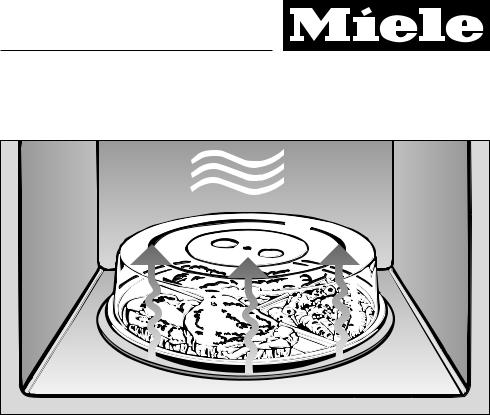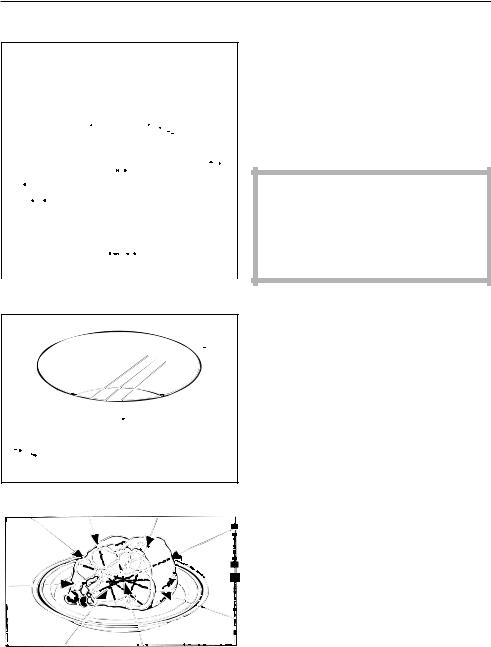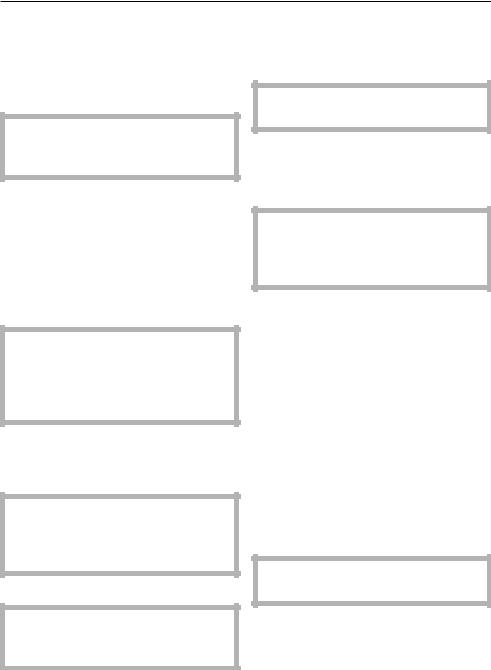Miele M 635 EG User Manual

Operating instructions
Microwave oven
M 635 EG
It is essential to read these operating instructions before installing or using the machine, to avoid the risk of accidents or damage to the machine.
WOGZ
M.-Nr. 05 260 120

Contents
Description of the appliance. . . . . . . . . . . . . . . . . . . . . . . . . . . . . . . . . . . . . . . . . 4
Caring for the environment . . . . . . . . . . . . . . . . . . . . . . . . . . . . . . . . . . . . . . . . . . 5
Warning and safety instructions . . . . . . . . . . . . . . . . . . . . . . . . . . . . . . . . . . . . . 6
How the microwave oven functions . . . . . . . . . . . . . . . . . . . . . . . . . . . . . . . . . . 12
Suitable containers for microwave ovens . . . . . . . . . . . . . . . . . . . . . . . . . . . . . 13 Material and shape . . . . . . . . . . . . . . . . . . . . . . . . . . . . . . . . . . . . . . . . . . . . . . . . 13 Testing dishes for their suitability. . . . . . . . . . . . . . . . . . . . . . . . . . . . . . . . . . . . . . 15
Accessories . . . . . . . . . . . . . . . . . . . . . . . . . . . . . . . . . . . . . . . . . . . . . . . . . . . . . 16 Accessories supplied . . . . . . . . . . . . . . . . . . . . . . . . . . . . . . . . . . . . . . . . . . . . . . 16 A cover . . . . . . . . . . . . . . . . . . . . . . . . . . . . . . . . . . . . . . . . . . . . . . . . . . . . . . . 16 Grilling rack. . . . . . . . . . . . . . . . . . . . . . . . . . . . . . . . . . . . . . . . . . . . . . . . . . . . 16 Glass tray . . . . . . . . . . . . . . . . . . . . . . . . . . . . . . . . . . . . . . . . . . . . . . . . . . . . . 16 Optional accessories . . . . . . . . . . . . . . . . . . . . . . . . . . . . . . . . . . . . . . . . . . . . . . . 17 Gourmet plate (MGP 24). . . . . . . . . . . . . . . . . . . . . . . . . . . . . . . . . . . . . . . . . . 17
Preparation for use . . . . . . . . . . . . . . . . . . . . . . . . . . . . . . . . . . . . . . . . . . . . . . . 18 Setting time of day . . . . . . . . . . . . . . . . . . . . . . . . . . . . . . . . . . . . . . . . . . . . . . . . . 18 Altering the time of day . . . . . . . . . . . . . . . . . . . . . . . . . . . . . . . . . . . . . . . . . . . . . 18 Switching off the time of day display . . . . . . . . . . . . . . . . . . . . . . . . . . . . . . . . . . . 18 Night time. . . . . . . . . . . . . . . . . . . . . . . . . . . . . . . . . . . . . . . . . . . . . . . . . . . . . . . . 18 Minute minder . . . . . . . . . . . . . . . . . . . . . . . . . . . . . . . . . . . . . . . . . . . . . . . . . . . . 18 To open the door . . . . . . . . . . . . . . . . . . . . . . . . . . . . . . . . . . . . . . . . . . . . . . . . . . 19 To close the door . . . . . . . . . . . . . . . . . . . . . . . . . . . . . . . . . . . . . . . . . . . . . . . . . . 19 Audible tone. . . . . . . . . . . . . . . . . . . . . . . . . . . . . . . . . . . . . . . . . . . . . . . . . . . . . . 19 Safety lock . . . . . . . . . . . . . . . . . . . . . . . . . . . . . . . . . . . . . . . . . . . . . . . . . . . . . . . 19
Operation . . . . . . . . . . . . . . . . . . . . . . . . . . . . . . . . . . . . . . . . . . . . . . . . . . . . . . . 20 Types of operation . . . . . . . . . . . . . . . . . . . . . . . . . . . . . . . . . . . . . . . . . . . . . . . . . 20 Microwave-Solo mode . . . . . . . . . . . . . . . . . . . . . . . . . . . . . . . . . . . . . . . . . . . . . . 20 Microwave power settings . . . . . . . . . . . . . . . . . . . . . . . . . . . . . . . . . . . . . . . . 20 Times for defrosting, reheating, cooking . . . . . . . . . . . . . . . . . . . . . . . . . . . . . 20 Placing the container in the oven . . . . . . . . . . . . . . . . . . . . . . . . . . . . . . . . . . . 21 Turntable . . . . . . . . . . . . . . . . . . . . . . . . . . . . . . . . . . . . . . . . . . . . . . . . . . . . . . 21 Starting a process. . . . . . . . . . . . . . . . . . . . . . . . . . . . . . . . . . . . . . . . . . . . . . . 22 Interrupting a process / Re-starting a process. . . . . . . . . . . . . . . . . . . . . . . . . 22 Altering settings . . . . . . . . . . . . . . . . . . . . . . . . . . . . . . . . . . . . . . . . . . . . . . . . 22 To cancel a process . . . . . . . . . . . . . . . . . . . . . . . . . . . . . . . . . . . . . . . . . . . . . 22 Automatic "warming" function . . . . . . . . . . . . . . . . . . . . . . . . . . . . . . . . . . . . . . . . 23 Quick-Start (programmable) . . . . . . . . . . . . . . . . . . . . . . . . . . . . . . . . . . . . . . . . . 23
2

Contents
Programming the end of cooking time. . . . . . . . . . . . . . . . . . . . . . . . . . . . . . . . . . 24
Reheating . . . . . . . . . . . . . . . . . . . . . . . . . . . . . . . . . . . . . . . . . . . . . . . . . . . . . . . 25
Cooking. . . . . . . . . . . . . . . . . . . . . . . . . . . . . . . . . . . . . . . . . . . . . . . . . . . . . . . . . 26
Defrosting / Defrosting and reheating / cooking. . . . . . . . . . . . . . . . . . . . . . . . 27
Practical tips. . . . . . . . . . . . . . . . . . . . . . . . . . . . . . . . . . . . . . . . . . . . . . . . . . . . . 28
Grilling . . . . . . . . . . . . . . . . . . . . . . . . . . . . . . . . . . . . . . . . . . . . . . . . . . . . . . . . . 29 Combination mode - Microwave + Grill . . . . . . . . . . . . . . . . . . . . . . . . . . . . . . . . . 30
Automatic programmes. . . . . . . . . . . . . . . . . . . . . . . . . . . . . . . . . . . . . . . . . . . . 31
Cleaning and care . . . . . . . . . . . . . . . . . . . . . . . . . . . . . . . . . . . . . . . . . . . . . . . . 32
Problem solving guide. . . . . . . . . . . . . . . . . . . . . . . . . . . . . . . . . . . . . . . . . . . . . 35
After Sales Service . . . . . . . . . . . . . . . . . . . . . . . . . . . . . . . . . . . . . . . . . . . . . . . 37
Electrical connection . . . . . . . . . . . . . . . . . . . . . . . . . . . . . . . . . . . . . . . . . . . . . 38 Electrical connection U.K. . . . . . . . . . . . . . . . . . . . . . . . . . . . . . . . . . . . . . . . . . . . 38 Electrical connection AUS / NZ . . . . . . . . . . . . . . . . . . . . . . . . . . . . . . . . . . . . . . . 40
Installation and connection . . . . . . . . . . . . . . . . . . . . . . . . . . . . . . . . . . . . . . . . 41
Technical data . . . . . . . . . . . . . . . . . . . . . . . . . . . . . . . . . . . . . . . . . . . . . . . . . . . 42
3

Description of the appliance
aAppliance door bDoor lock
cGrill / browning element dControl panel
eGlass tray fTurntable gGrilling rack
hElectronic clock with display
iSelector switch for microwave-power levels and automatic programmes
jRotary selector: time, weight, temperature, grill setting
kGrill button n
lButton for programming end of cooking time r
mAutomatic warming function button W
nTime of day button m oMinute minder button l pStop / cancel button
qTurntable button ä
rSTART/Quick-Start (programmable) c
sDoor release button a
Using the microwave oven
–Food can be defrosted, re-heated or cooked by entering a power setting and a time.
–Deep frozen ready-made meals can be defrosted and then re-heated or cooked.
–The microwave oven can also be used for other tasks, e.g. for proving dough, melting chocolate and butter, dissolving gelatine etc.
4

Caring for the environment
Disposal of the packing material
The transport and protective packing has been selected from materials which are environmentally friendly for disposal and can normally be recycled.
Ensure that any plastic wrappings, bags etc. are disposed safely and kept out of the reach of babies and young children. Danger of suffocation!
Rather than just throwing these materials away, please ensure they are offered for recycling.
Disposal of your old appliance
Old appliances may contain material which can be reclaimed or recycled. Please contact your dealer, your local waste collection centre or scrap merchant about potential recycling schemes.
Ensure that the appliance presents no danger to children while being stored for disposal.
See the appropriate section in the Warning and Safety instructions.
5

Warning and safety instructions
This appliance complies with all relevant legal safety requirements. Before installation and before using the appliance for the first time, read the operating instructions carefully. They contain important notes on installation, safety, operation and care of the appliance. This way you will avoid the risk of accidents and damage to the appliance.
Keep these instructions in a safe place and pass them on to any future user.
Correct usage
The appliance is intended for domestic use only to defrost, reheat, cook and to grill food: Any other usage
is not supported by the manufacturer and could be dangerous.
The manufacturer cannot be held responsible for damage caused by improper use of the appliance.
Never use the microwave to store or dry items which could ignite
easily. Fire hazard!
Do not let children access the appliance or its controls. Supervise its
use by older children, the elderly or infirm. Please ensure that they are aware of how a microwave oven works and understand the dangers of improper use.
Technical safety
Do not use the microwave if
–the door is warped.
–the door hinges are loose.
–holes or cracks are visible in the casing, the door, the door seal or the oven interior walls.
Operating the appliance with this type of damage will result in microwave leakage, and present a hazard to the user.
Repairs may only be carried out by a suitably qualified and competent person in accordance with national and
local safety regulations. Repairs and other work by unqualified persons could be dangerous. The manufacturer cannot be held responsible for unauthorised work.
Never open the casing of the appliance.
Tampering with electrical connections or components and mechanical parts is highly dangerous to the user and can cause operational faults or electric shock.
If the connection cable is damaged the new cable must be fitted by a
Miele approved service technician.
Before connecting the appliance to the mains supply make sure that
the rating on the data plate corresponds to the voltage and frequency of the household supply. This data must correspond in order to avoid risk of damage to the appliance. Consult a suitably qualified person if in doubt.
6

Warning and safety instructions
The electrical safety of this appliance can only be guaranteed when
continuity is complete between the appliance and an effective earthing system, which complies with local and national safety regulations. It is most important that this basic safety requirement is present. If in any doubt, the electrical wiring should be checked by a qualified electrician.
The manufacturer cannot be held liable for the consequences of an inadequate earthing system (e.g. electric shock).
The appliance is only completely isolated from the electricity supply
when:
–it is switched off at the wall socket and the plug removed.
Do not pull on the cable, only on the plug.
–the mains fuse is withdrawn.
–or the screw-out fuse is removed (in countries where this is applicable).
Do not connect the appliance to the mains electricity supply by an
extension lead.
Extension leads do not guarantee the required safety of the appliance, (e.g. danger of overheating).
Ensure that current is not supplied to the appliance while maintenance
or repair work is being carried out.
This equipment is not designed for maritime use or for use in mobile
installations such as caravans, aircraft etc. However it may be suitable for such usage subject to a risk assessment of the installation being carried out by a suitably qualified engineer.
Use
Always ensure that food is sufficiently heated.
Many factors will affect the overall cooking time, including the size and amount of food, its initial temperature, changes to the recipe and the shape and size of cooking container.
Some foods may contain micro organisms which are only destroyed by thorough cooking, therefore when cooking or reheating foods, e.g. poultry, it is particularly important that food is fully cooked through (at temperatures over 70 °C for at least 10 minutes). If in doubt select a longer cooking or reheating time.
It is important that the heat is allowed to spread evenly throughout
the food being cooked.
This can be achieved by stirring and/or turning the food, and by observing a sufficiently long standing time, which should be added to the time needed for cooking, re-heating or defrosting.
Always remember that times for cooking, reheating and defrosting
are usually considerably shorter than with traditional methods of food preparation.
Excessively long cooking times can lead to food drying out and burning, or could even cause it to catch fire. There is also a danger of fire if breadcrumbs, flowers, herbs, etc., are dried in the microwave oven. Always ensure that this type of procedure is supervised.
7

Warning and safety instructions
Do not use the microwave to heat up herb cushions or pads filled
with wheat grains or lavender, such as those used in aromatherapy. These pads can ignite when heated even after they have been removed from the microwave.
Fire hazard!
Exercise caution when cooking or reheating food with a high sugar
content, e.g. Christmas pudding. If heated for too long the sugar may caramelise or ignite.
Do not use full power if you warm empty dishes or dry herbs. The
lack or minimum amount of food could cause damage to the appliance.
Never cook or reheat food or liquids in sealed containers or bot-
tles.
With baby bottles the screw top teat must be removed.
Otherwise pressure builds up which can cause the bottle or container to explode posing a severe risk of injury.
Before serving remember to allow a sufficient standing time and then
always check the temperature of the actual food itself after taking it out of the microwave. Do not be misled by the temperature of the container which does not necessarily give a correct indication of the temeparature of the food or liquid in it. This is particularly important when preparing food for babies, children, and the elderly or infirm.
When heating liquids, the boiling rod provided should be placed into
the container.
When heating liquids, milk, sauces etc., in the oven without the boiling rod, the boiling point of the liquid may be reached without the production of typical bubbles. The liquid does not boil evenly throughout. This so-called ‘boiling delay’ can cause a sudden build up of bubbles, when the container is removed from the oven or shaken. This can lead to the liquid boiling over suddenly and explosively. Danger of burning!
The formation of bubbles can be so strong that the pressure forces the oven door open. The user could be injured and the appliance damaged.
The boiling rod ensures that the liquid boils evenly and that bubbles form at an early stage during the operation.
8

Warning and safety instructions
If smoke occurs in the oven interior, to avoid fuelling any flame do not
open the oven door.
Interrupt the process (by pressing the Stop/C button twice). Switch off at the wall socket and where applicable, remove the plug. Do not open the oven door until the smoke has dispersed.
Never heat undiluted alcohol in the microwave oven as this can easily
ignite. This is a fire hazard.
Do not heat up tins in the microwave oven. Pressure can build up
and they may explode. This could result in injury or damage.
Do not use any containers or cutlery made from or containing metal,
aluminium foil, lead crystal glassware, temperature-sensitive plastics, wooden utensils or cutlery, metal clips or wire ties. Do not use bowls with milled rims, or cream pots with the foil lid only partially removed.
Such items could be damaged, or cause a fire hazard.
The rack supplied with the appliance is designed to be compatible with microwaves, and can therefore be used for grilling with or without the microwave function.
Do not leave the oven unattended when reheating or cooking food in disposable containers made of plastic,
paper or other inflammable material. Before using single use containers make sure they are suitable for use in microwave ovens. See appropriate section.
Eggs can only be cooked in their shells in the microwave oven in a specially designed egg-boiling device
available from specialist shops. Similarly, hard-boiled eggs should not be reheated in the microwave as this may lead to the eggs bursting, even once they have been removed from the oven.
Eggs can be cooked without their shells in the microwave oven only if
the yolk membrane has been punctured several times first.
The pressure could otherwise cause the egg yolk to explode.
Danger of injury.
Food with a thick skin or peel, such as tomatoes, sausages, jacket po-
tatoes and aubergines, should be pierced or the skin cut in several places before cooking to allow steam to escape and prevent the food from bursting.
Do not reheat food in the oven in heat-retaining bags, such as those
used for ready grilled chicken or naan bread from take-aways which are intended for use in normal ovens. These heat-retaining bags usually contain a thin layer of aluminium foil which reflects microwaves. This reflected energy can, in turn, cause the outer paper covering to become so hot that it ignites.
9

Warning and safety instructions
Always ensure that food or a browning dish has been placed in
the microwave, and that the turntable is in place, before switching on.
Do not leave the oven unattended when cooking with oils and fats as these can be a fire hazard if allowed to
overheat.
Ovenproof earthenware can retain a considerable amount of moisture.
Earthenware and porcelain containers with hollow handles and lid knobs must only be used in this oven if they have vent holes which allow the moisture to escape. Without vent holes there can be a pressure build-up, causing the container to crack or shatter, with the danger of injury.
With all functions except microwave solo mode the rack, oven in-
terior, grill element, side runners, door and housing can get hot! Do not let small children touch the oven while it is in operation, there is the danger of being burnt. Supervise its use by the elderly or infirm.
Wear oven gloves when taking dishes in and out of the oven, or
when handling dishes or food in the oven if the grill is on or has just been in operation. Danger of burning.
The rack and glass tray get hot during grilling (with and without mi-
crowave). Danger of burning.
Only use the baking tray with the fan heat function. It must not be
used with the microwave function.
Never place the hot glass tray (or any other hot cooking containers)
on a cold surface, such as a tiled or granite worktop. The glass tray or container could crack or shatter, and the worktop surface could be damaged. Use a heat-resistant mat or wire cooling rack.
Do not use the oven to heat up the room. Due to the high temperatures
radiated, objects left near the oven could catch fire.
Do not use the appliance as a resting place for other items.
The heat from the top of the appliance could cause some kinds of items to melt.
To check the temperature of the food, first interrupt the cooking pro-
cess. Then use a thermometer specifically approved for food use to measure the temperature of the food. Never use a thermometer containing mercury or liquid, as these are not suitable for use with very high temperatures and will break very easily.
Never use a steam-cleaning appliance to clean this appliance. Pres-
surised steam could reach the electrical components and cause a short circuit.
In countries where there are areas which may be subject to infestation
by cockroaches or other vermin, pay particular attention to keeping the appliance and its surroundings in a clean condition at all times. Any damage which may be caused by cockroaches or other vermin will not be covered by the appliance guarantee.
10

Warning and safety instructions
When using browning dishes:
Always use oven gloves when handling the browning dish to avoid
burns.
Never place the browning dish directly on to a table or work surface.
Use a suitable heat-resistant mat, grid or board to protect the work surface or table and prevent heat-marks.
Browning dishes should only be used in a microwave oven, or as a
serving dish.
In a conventional oven the special glaze would get damaged.
Disposal of your old appliance
Before disposing of your old appliance first make it unusable. Cut off and render any plug unusable. Cut off the cable directly behind the appliance to prevent misuse. This should be done
by a competent person.
The manufacturer cannot be held liable for damage caused by non-com- pliance with these Warning and Safety instructions.
11

How the microwave oven functions
In the microwave oven, food is cooked, reheated or defrosted quickly.
How does the microwave oven function?
In a microwave oven there is a high-fre- quency tube called a magnetron. This converts electrical energy into microwaves. These microwaves are distributed evenly throughout the oven interior and rebound off the metal sides of the oven interior to reach the food from all sides. Microwave distribution is improved with the turntable engaged.
In order for microwaves to reach the food, they must be able to penetrate the cooking utensil being used. Microwaves can penetrate porcelain, glass, cardboard and plastics but not metal. Do not, therefore, use utensils made of metal, or which contain metal, for example in the form of gold or silver trim. The metal reflects the microwaves and this could lead to the creation of sparks. The microwaves cannot be absorbed.
Microwaves pass through a suitable container and find their way directly into the food. All food contains moisture molecules which, when subjected to microwave energy, start to oscillate 2.5 thousand million times a second. The friction caused by this vibration creates heat, which first starts developing around the outside of the food and then slowly penetrates towards the centre. The moisture, fat and sugar content of food will affect the speed at which it is cooked.
As heat is produced directly in the food,
–food can generally be cooked without adding much liquid or cooking oil.
–cooking, reheating and defrosting in a microwave oven is quicker than using conventional methods.
–nutrients, such as vitamins and minerals, are generally retained.
–colour, texture and taste of food are not impaired.
Microwaves stop being produced as soon as the cooking process is interrupted or the appliance door is opened. When the appliance is in operation, the closed, sealed door prevents microwaves escaping from the appliance.
12

Suitable containers for microwave ovens
Microwaves |
Material and shape
The material and shape of containers used affect cooking results and times. Heat distribution is more even in round and oval shaped flat containers than in rectangular containers, providing better results.
Metal
Metal containers, aluminium foil and metal cutlery, or china with metallic decoration, such as gold rims or cobalt blue must not be used in an oven being used in microwave mode.
– are reflected by metal,
– pass through glass and chinaware,
– and are absorbed by food.
The metal reflects the microwaves, hindering the cooking process.
Exceptions:
–If recommended by the producer, pre-cooked meals packed in aluminium foil containers can be defrosted and reheated in the microwave oven. Important: Remove the lid first.
However, as food is only heated from the top it is better to remove the food from the aluminium foil container and transfer it to a dish suitable for a microwave oven. The heat distribution will be more even.
If sparks and arcing occur when using an aluminium container, stop and transfer the food to a microwave safe container.
13

Suitable containers for microwave ovens
–For even defrosting and to avoid overcooking unevenly shaped cuts of meat, poultry or fish, small pieces of aluminium foil may be used to mask wingtips or other thin parts for the last few minutes of the process.
Make sure that the aluminium foil is at least 2 cm from the oven walls at all times. It must not touch the walls.
–Metal meat skewers or clamps should only be used if they are very small in comparison to the size of the cut of meat.
Glassware
Heat-resistant glass or ceramic glass are ideal for use in the microwave oven.
Crystal glass contains lead which could cause the glass to crack. Glass dishes with a milled rim are also subject to this risk.
Both are unsuitable.
Porcelain (chinaware)
Porcelain (chinaware) is a suitable material.
Do not use porcelain with gold or silver edging or items with hollow knobs or handles, as insufficient ventilation may cause pressure.
Earthenware
Decorated earthenware is only suitable if the decoration is beneath an all-over glaze.
Earthenware can get very hot, and may crack.
Glazes and colours
Some glazes and colours contain metal.
This makes them unsuitable for use in a microwave oven.
Plastics
Plastic containers must only be used for microwave mode alone.
Plastics must be heat-resistant to a minimum of 110 °C.
Otherwise the plastic may melt and fuse with the food.
Special plastic utensils, designed for use in microwave ovens are available from good retail outlets.
Melamine is not suitable as it absorbs energy and heats up.
Disposable containers, such as trays made from polystyrene, can only be used for very short timed warming and reheating of food.
When purchasing new containers, make sure that they are suitable for use in a microwave oven.
Plastic boiling bags can be used for cooking and reheating.
They should be pierced beforehand so that steam can escape. This prevents a build-up of pressure and reduces the risk of the bag bursting.
14
